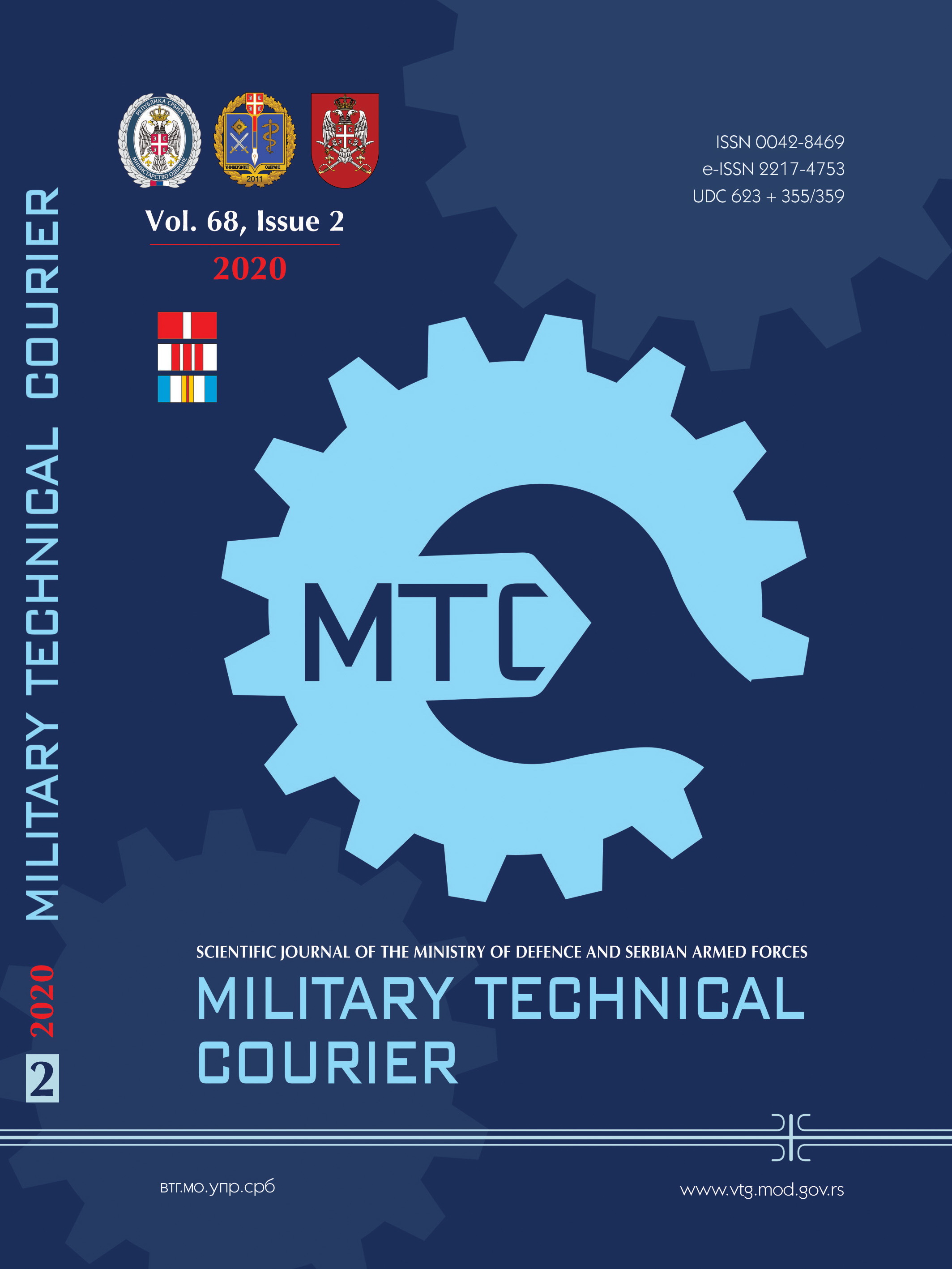Aircraft collision prediction based on binomial distribution
Abstract
Introduction/purpose: Based on the binomial distribution of the probability density function, a new probabilistic model for aircraft position predicting is presented in this paper.
Methods: The proposed algorithm is composed of three different blocks: Data Association, Tracking/Hybrid State Estimation and Calculation of Probability of Conflict. The information about aircraft current positions and flight plans is used to derive an algorithm for detecting possible conflicts between aircraft. The situations where aircraft may come closer than a certain distance to one another are predicted with high probability. The position estimate and indeterminacy refer to target association when two tracks fall in a validation region by using the Probabilistic Data Association Filter.
Results: An efficient collision detection algorithm is designed and tested for a lot of multiple target tracking.
Conclusion: The simulation results of aircraft conflict prevention in two trajectory scenarios verify the efficiency of the proposed algorithm.
References
Bar-Shalom, Y., & Dale Blair, W. 2000. Multitarget multisensor tracking: applications and advanced, Volume 3. Norwood, MA: Artech House.
Bar-Shalom, Y., & Fortmann, T.E. 1988. Tracking and Data Association, San Diego, CA: Academic Press.
Bar-Shalom, Y., & Li, X., 1999. Multitarget-multisensor tracking: principles and techniques. Norwood, MA: Artech House.
Bar-Shalom, Y., & Tse, E. 1975. Tracking in a Cluttered Environment with Probabilistic Data Association. Automatica, 11(5), pp.451-460. Available at: https://doi.org/10.1016/0005-1098(75)90021-7.
Blackman, S. 1986. Multiple-target tracking with radar applications. Dedham, MA: Artech House.
Challa, S., Morelande, M.R., Mušicki, D., & Evans, R. 2011. Fundamentals of Object Tracking. Cambridge, UK: Cambridge University Press.
de Feo, M., Graziano, A., Migliolo, R., & Farina, A. 1997. IMMJPDA versus MHT and Kalman filter with NN correlation: performance comparison. In: IEE Proceedings - Radar, Sonar and Navigation, 144(2), pp.49-56. April. Available at: https://doi.org/10.1049/ip-rsn:19970976.
Fitzgerald, R.J. 1990. Development of practical PDA logic for multitarget Multisensor tracking by microprocessor. In: Bar-Shalom, Y. (Ed.) Multitarget-Multisensor Tracking: Applications and Advances. Norwood, MA: Artech House, pp.1-23.
Gad, A., Farooq, M., Serdula, J., & Peters, D. 2004. Multitarget tracking in a multisensor multiplatform environment. In: Proceedings of the 7th International Conference on Information Fusion, Stockholm, Sweden, June 28 to July 1 [online]. Available at: http://www.fusion2004.foi.se/papers/IF04-0206.pdf.
Hu, J., Lygeros, J., Prandini, M. & Sastry, S. 1999. Aircraft conflict prediction and resolution using Brownian Motion. In: Proceedings of the 38th Conference on Decision & Control, Phoenix, Arizona USA, pp.2438-2443, December [online]. Available at: https://people.eecs.berkeley.edu/~sastry/pubs/OldSastryALL/HuAircraftConflict1999.pdf [Accessed: 26 April 2020].
Hu, J., Prandini M. & Sastry, S. 2005. Aircraft conflict prediction in the presence of a spatially correlated wind field. IEEE Transactions on Intelligent Transportation Systems, 6(3), pp.326-340. Available at: https://doi.org/10.1109/TITS.2005.853699.
Hwang, I. 2003. Air traffic surveillance and control using hybrid estimation and protocol based conflict resolution. PhD thesis. Stanford University.
Hwang, I., Hwang, J., & Tomlin, C. 2003. Flight-mode-based aircraft conflict detection using a Residual-Mean interacting multiple model algorithm. In: Proceedings of the AIAA Guidance, Navigation, and Control Conference, Austin, Texas, August 11-14. Available at: https://doi.org/10.2514/6.2003-5340.
Karlsson, R. 2002. Simulation based methods for target tracking. Licentiate thesis. Linköping University [online]. Available at: http://www.diva-portal.org/smash/record.jsf?pid=diva2%3A250444&dswid=-2785. [Accessed: 21 January 2020].
Nolan, M.S. 1998. Fundamentals of Air Traffic Control. Springer, The Wadsworth & Brooks/Cole Mathematics Series, 3rd edition.
Paielli, R.A., & Erzberger, H. 2012. Conflict probability estimation for free flight. Journal of Guidance, Control and Dynamics, 20(3), pp.588-596. Available at: https://doi.org/10.2514/2.4081.
Radosavljević, Z., & Mušicki, D. 2011. Limits of target tracking in heavy clutter. In: Proceedings ASIA-Pacific International Conference of Synthetic Aperture Radar APSAR, Seoul, Republic of Korea, September 26-30, ISBN: 978-899-3246-17-9.
Reid, D.B. 1979. An algorithm for tracking multiple targets. IEEE Transaction on Automatic Control, 24(6), pp.843-854. Available at: https://doi.org/10.1109/TAC.1979.1102177.
Song, T.L., Mušicki, D., Kim, D.S., & Radosavljević, Z. 2012. Gaussian mixtures in multi-target tracking: a look at Gaussian mixture probability hypothesis density and integrated track splitting. IET Radar, Sonar and Navigation, 6(5), pp.359-364. Available at: https://doi.org/10.1049/iet-rsn.2011.0263.
Valdés, R.M.A., Comendador, V.F.G., Sanz, L.P. & Sanz, A.R. 2018. Prediction of aircraft safety incidents using Bayesian inference and hierarchical structures. Safety science, 104(April), pp.216-230. Available at: https://doi.org/10.1016/j.ssci.2018.01.008.
Proposed Creative Commons Copyright Notices
Proposed Policy for Military Technical Courier (Journals That Offer Open Access)
Authors who publish with this journal agree to the following terms:
Authors retain copyright and grant the journal right of first publication with the work simultaneously licensed under a Creative Commons Attribution License that allows others to share the work with an acknowledgement of the work's authorship and initial publication in this journal.
- Authors are able to enter into separate, additional contractual arrangements for the non-exclusive distribution of the journal's published version of the work (e.g., post it to an institutional repository or publish it in a book), with an acknowledgement of its initial publication in this journal.
- Authors are permitted and encouraged to post their work online (e.g., in institutional repositories or on their website) prior to and during the submission process, as it can lead to productive exchanges, as well as earlier and greater citation of published work (See The Effect of Open Access).

